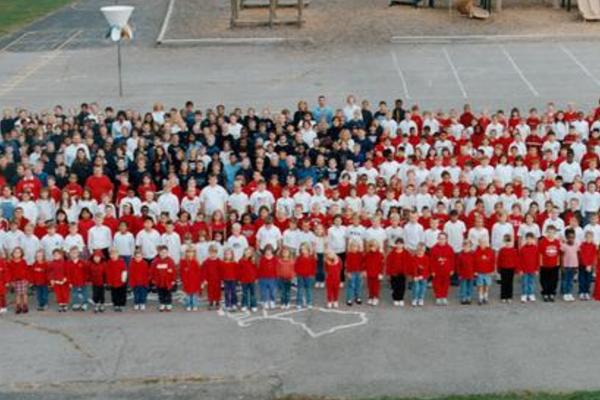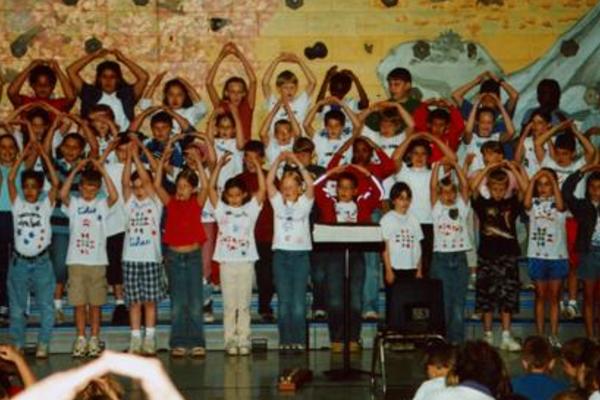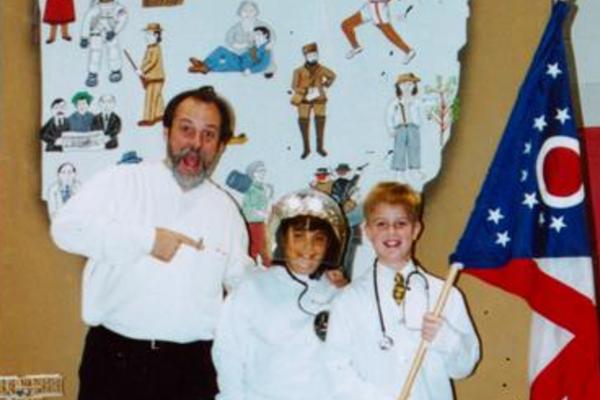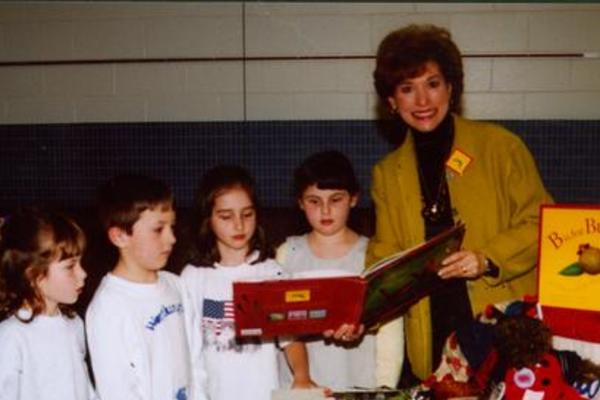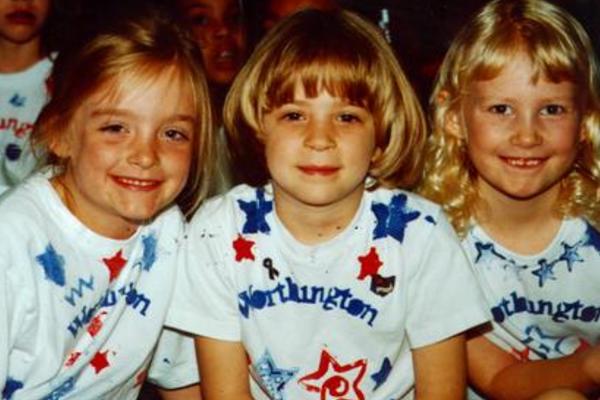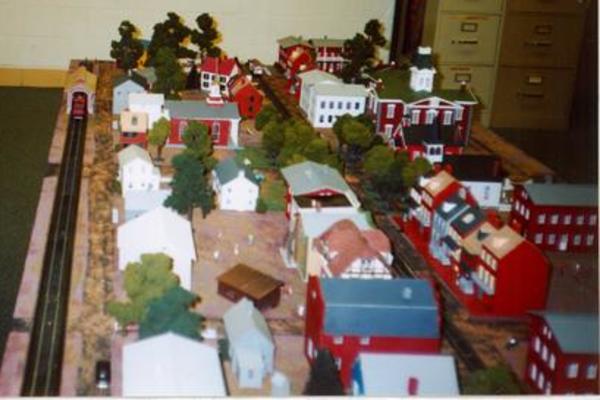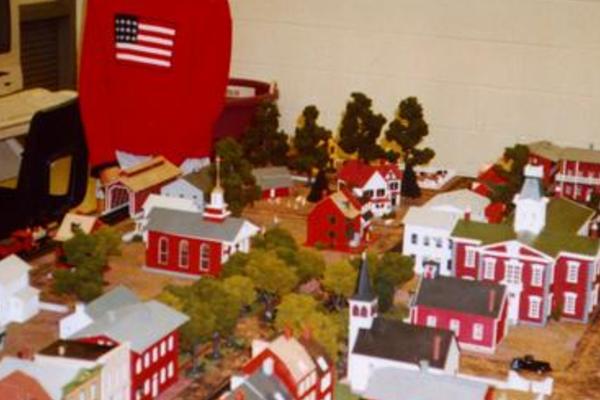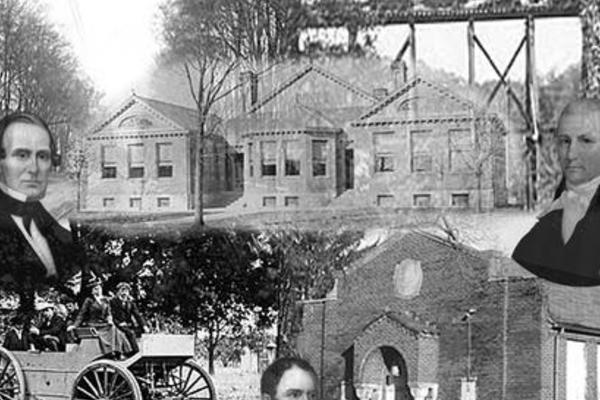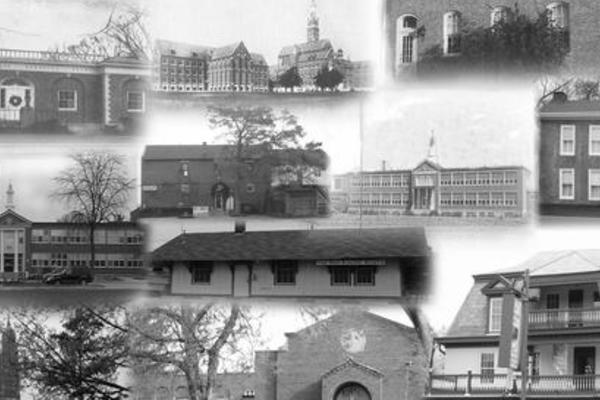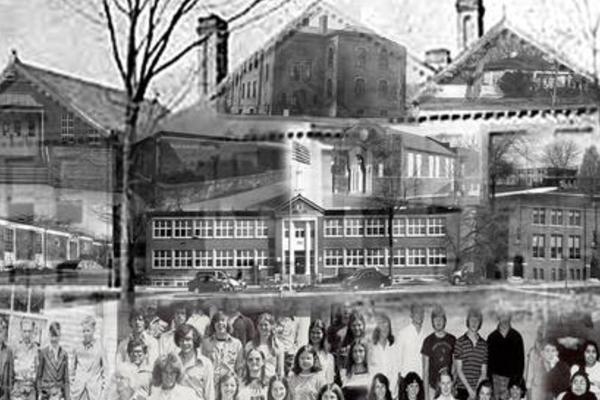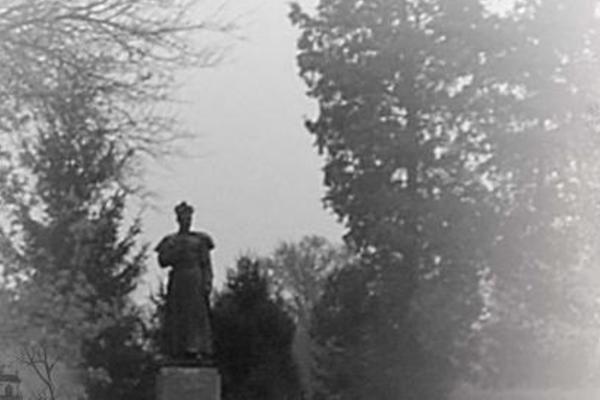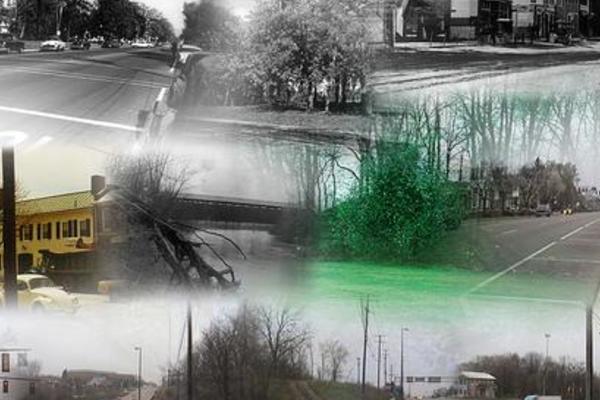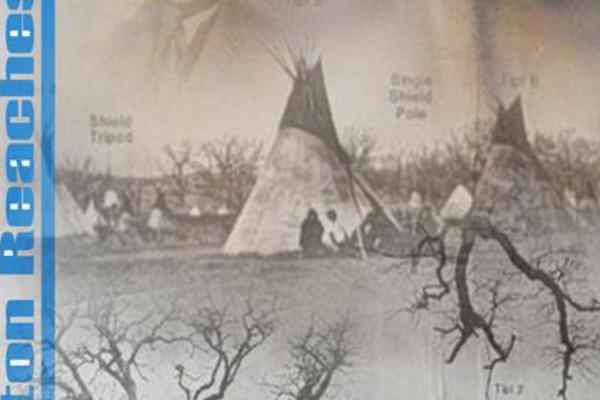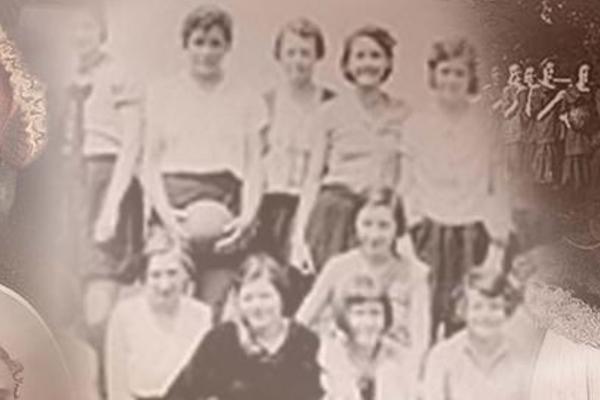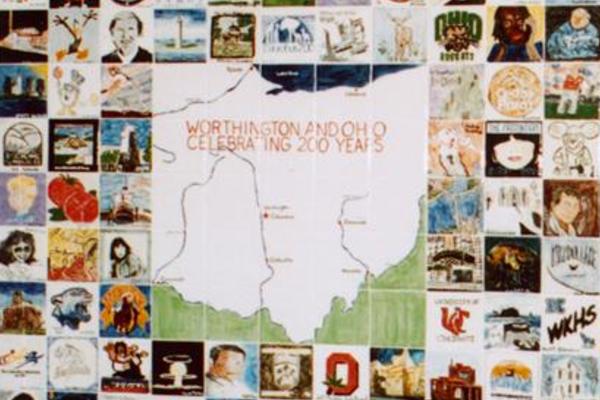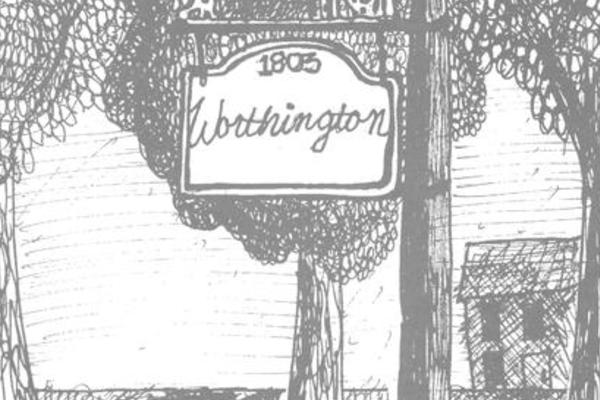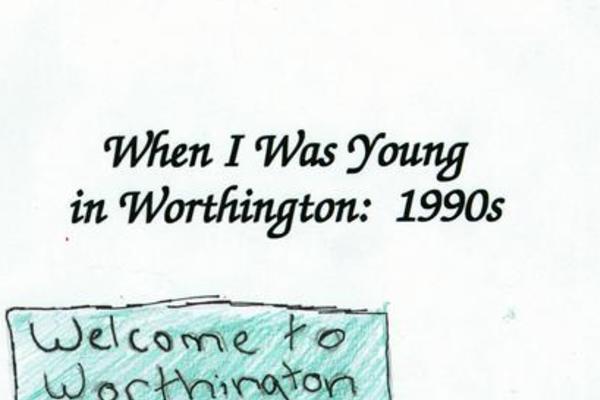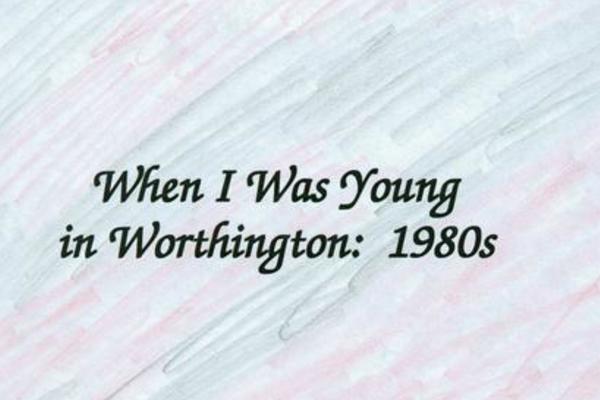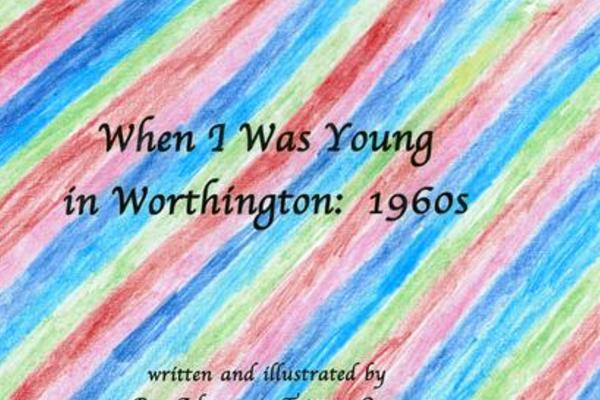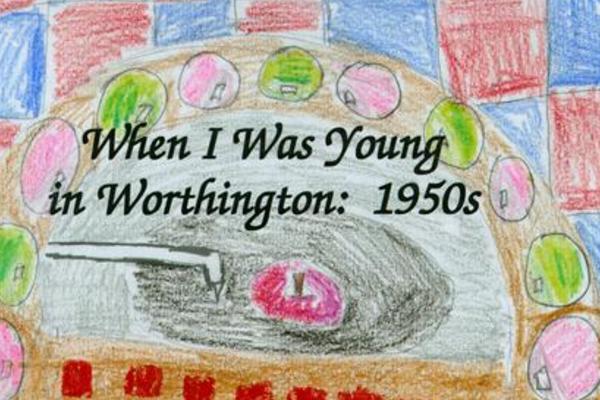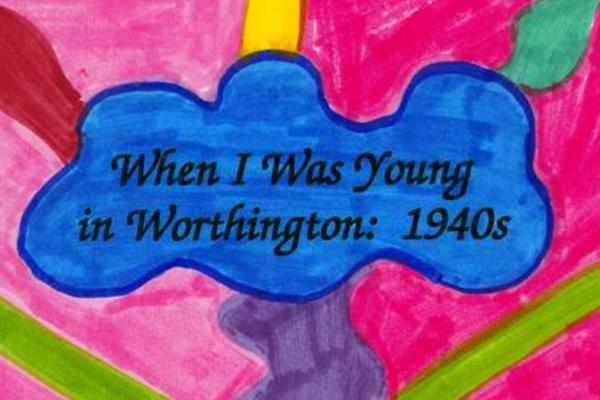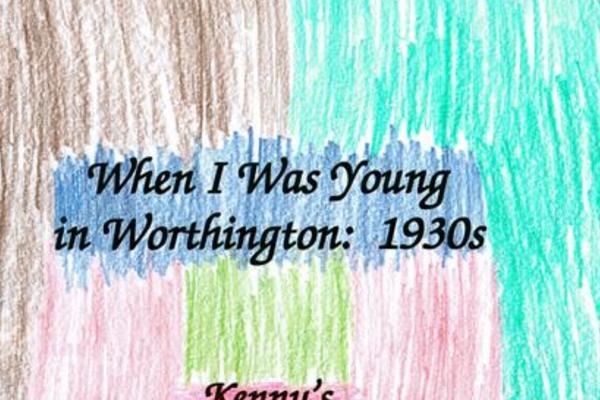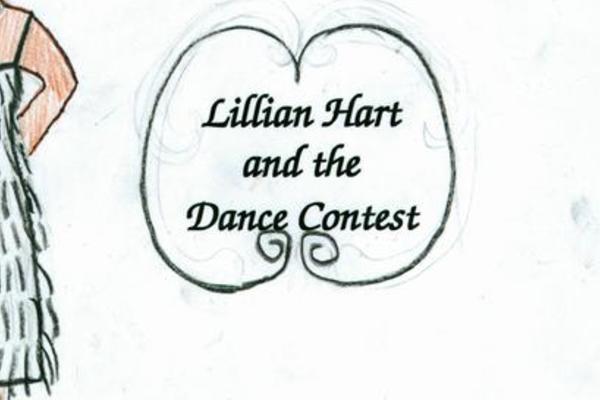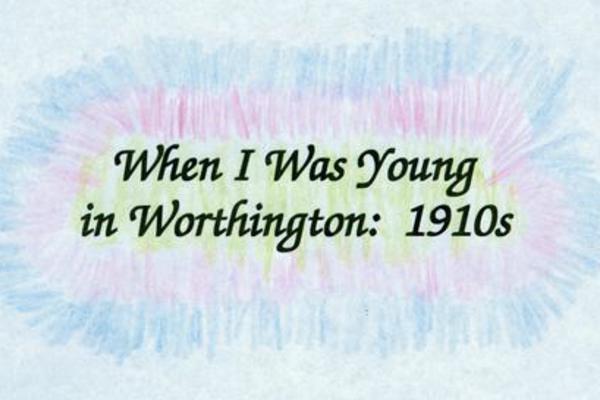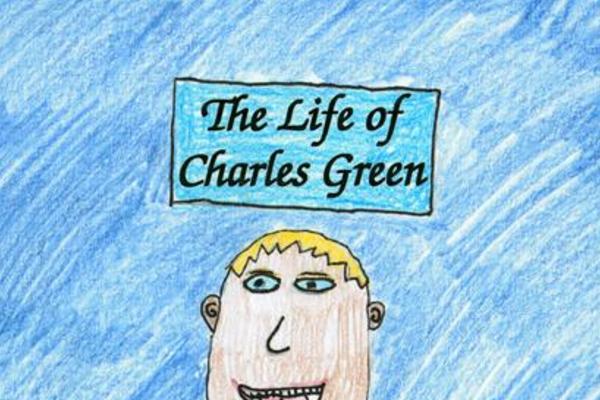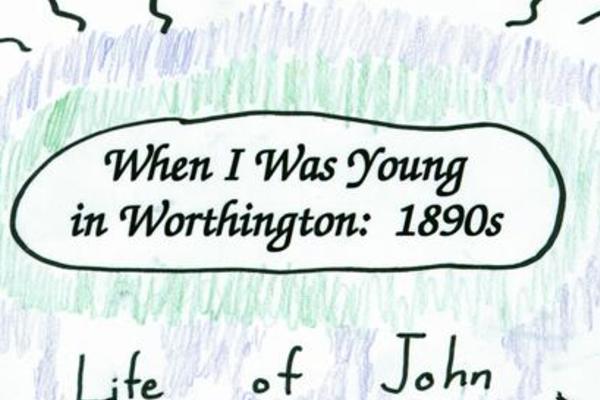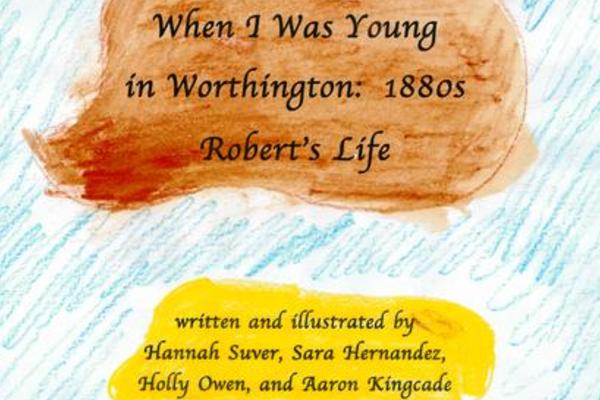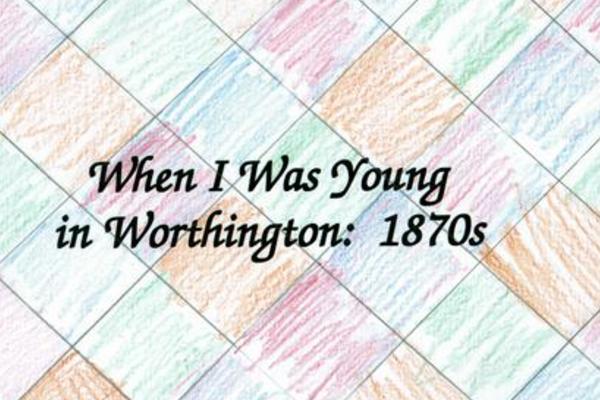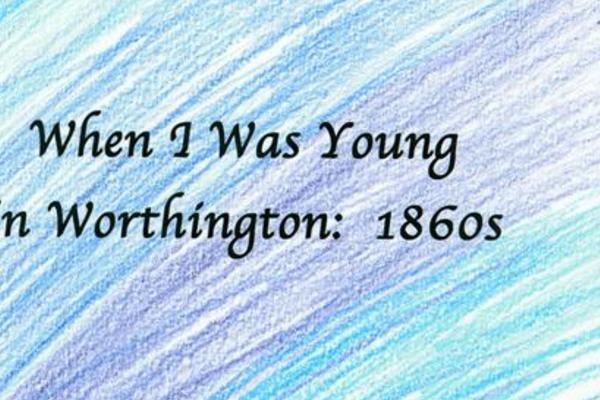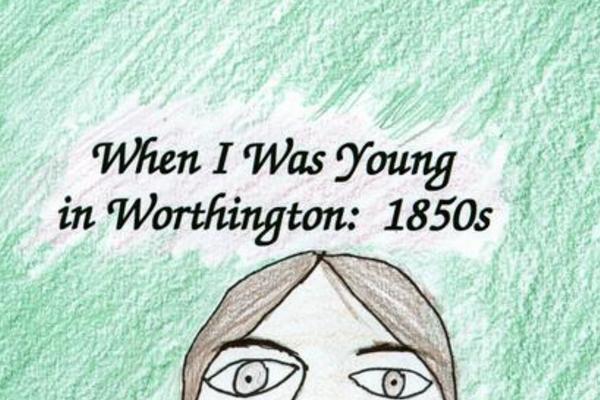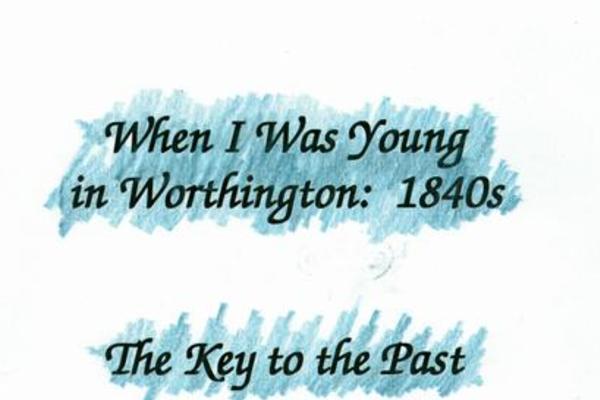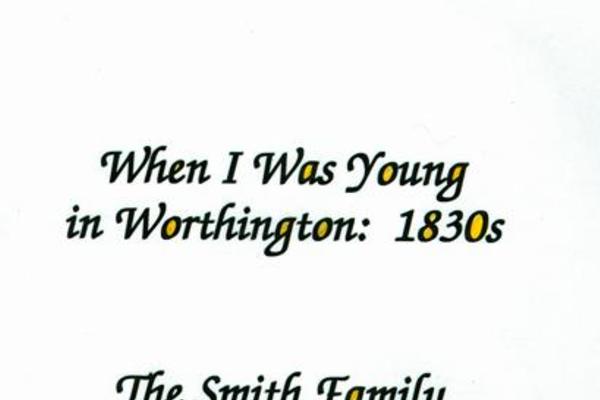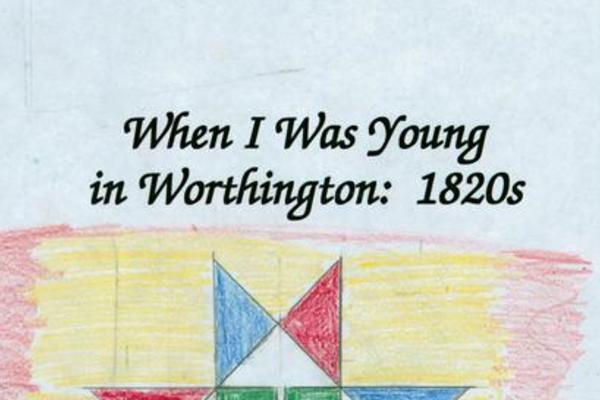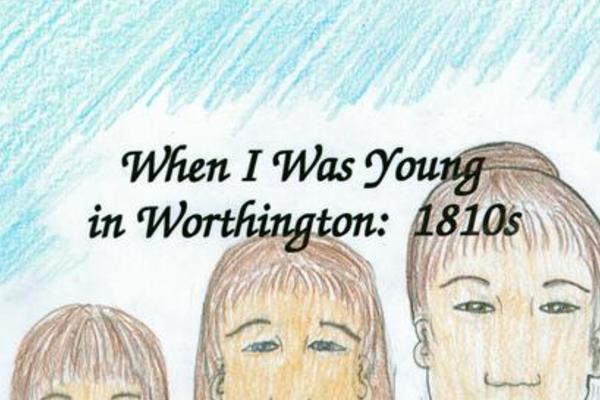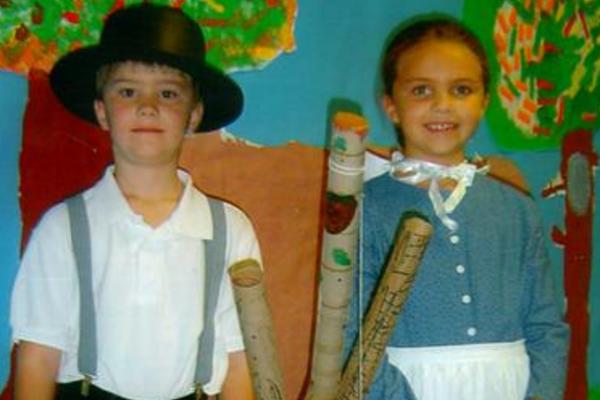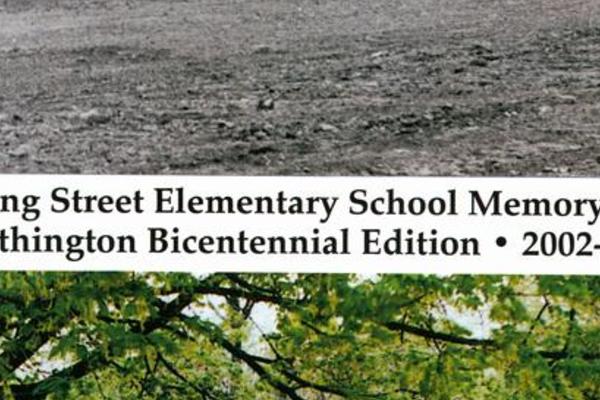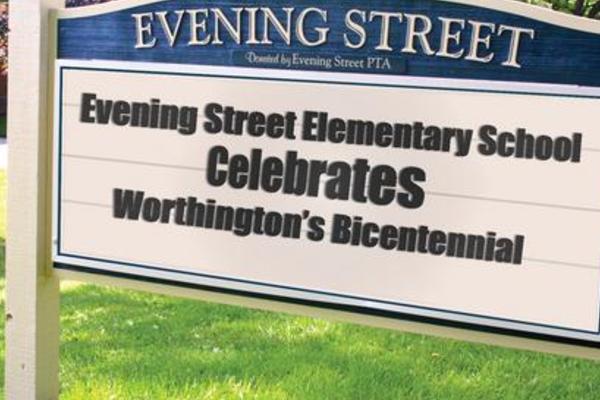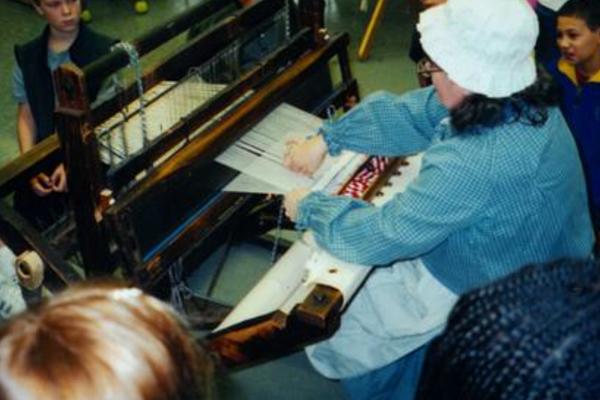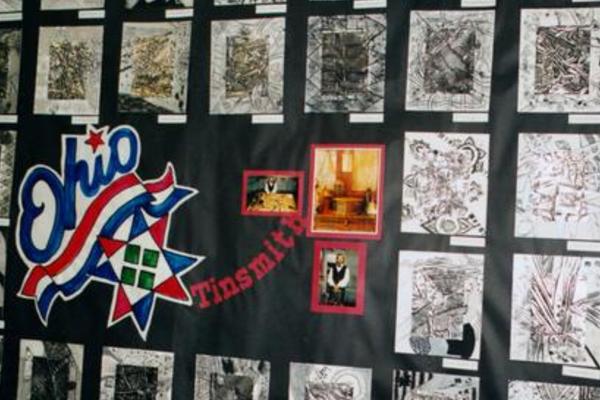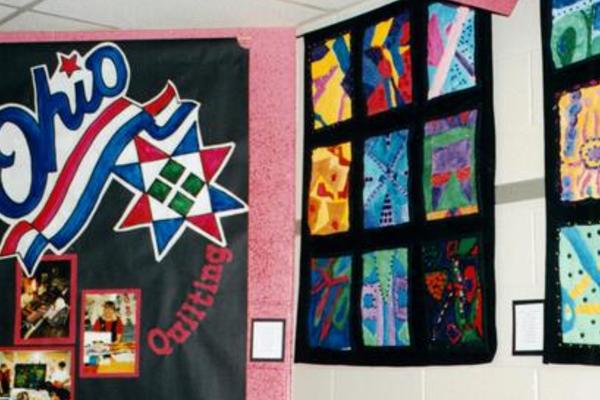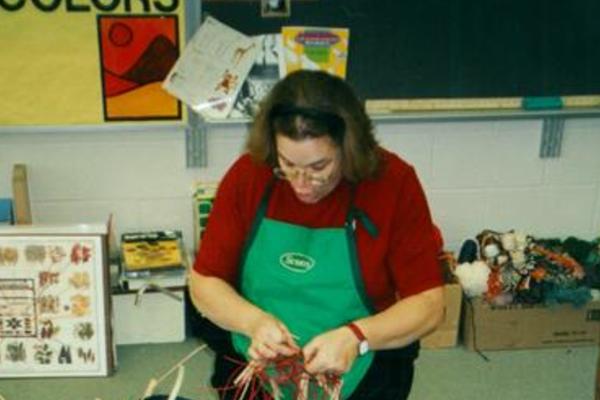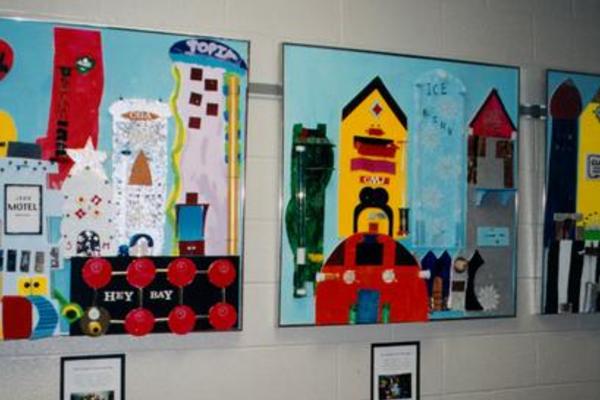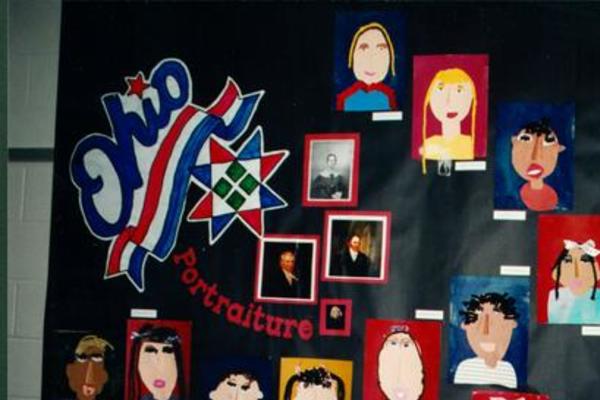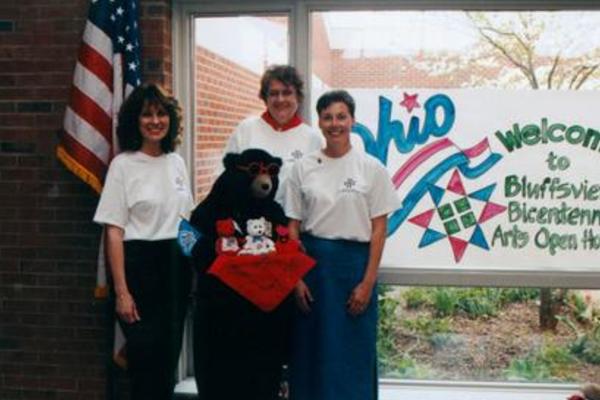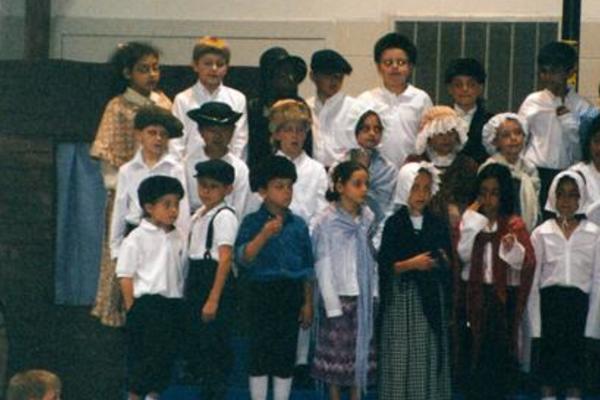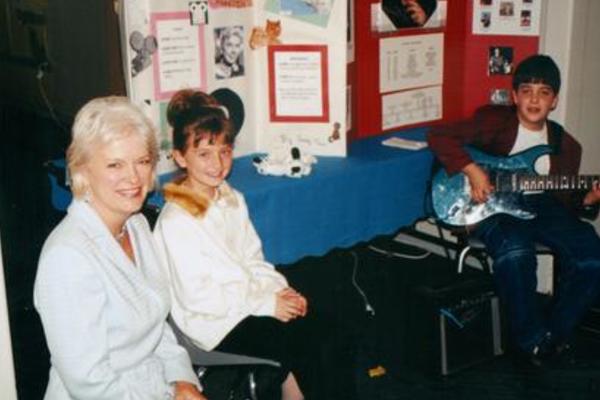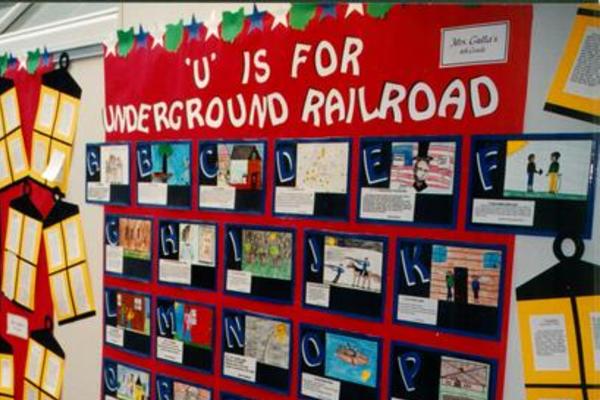Saturday,
November 1, 2003
9:50am
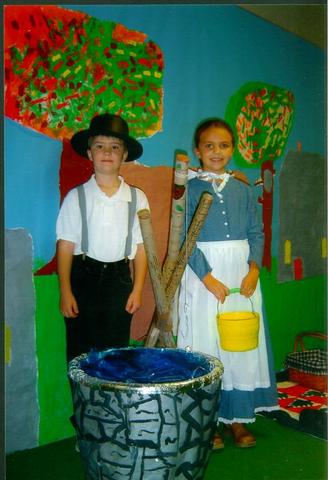
This collection features the ways in which schools in the Worthington School District celebrated the 200th Birthday of Worthington and Ohio. Special Bicentennial projects were completed by students in the Worthington School District during the City's year-long celebration. Many of these projects were funded by the City of Worthington's Bicentennial Steering Committee through the Worthington Bicentennial Teachers' Grants, which provides teachers in the Worthington school district the opportunity to create a Bicentennial project that includes use of Worthington Memory, thus enhancing the curriculum.
The City of Worthington and State of Ohio Bicentennials were celebrated at Worthington Estates School in several ways. The entire student body and the staff of Worthington Estates School formed the United States flag to recall that Ohio was the 17th state to enter the union in 1803. This photograph taken on the school grounds during the fall of 2002 as the City of Worthington's Bicentennial Celebration began.
One of the ways in which Worthignton Estates School celebrated the bicentennial of the State of Ohio and the City of Worthington was the Heroes of Ohio presentation, recalling 23 Ohio heroes.
Ohio author, Marica Schonberg visited Worthington Estates School during the 2002-2003 school year to share her book, "B is for Buckeye" with students. Young readers learn about Ohio history through each letter of the alphabet.
Worthington Estates School children created bicentennial T-shirts as one of the activities undertaken in celebration of the City of Worthington's 200th birthday. The bicentennial was celebrated during the 2002-2003 school year.
A buckeye tree was planted on the grounds of Worthington Estates School during the 2002-2003 school year in celebration of the 200th anniversary of the founding of Worthington and the statehood of Ohio. Dan Williams, Principal is pictured turning the shovel as students look on.
Three classes of fifth graders at Wilson Hill Elementary School constructed the model depicted here for a Worthington Bicentennial project called "Two Centuries of Growth and Change: The Worthington Community Buildings". All of the fifth grade students worked in small groups of 3 to 5 and researched a particular building that once stood or still remains in Worthington. Students spent time every week for months to create miniature models of the buildings and then create the village, complete with working street cars that represent the interurban which once provided light rail transportation on Route 23. Students then wrote reports about each structure and compiled them into a book, including photographs of the model. Copies of the reports are available at school libraries.
Wilson Hill fifth graders measured, calculated, glued, painted and wrote their way through the 2002-2003 school year as they recreated Worthington buildings as scale models. The construction project allowed students, with the help of staff and volunteers, to tie the fate of specific Worthington locales to many of the economic, social and political decisions students studied in existing pioneer, westward movement and Civil War units of study. Along the way, the fifth graders grappled with the mathematics of scale, researched events of significant impact to the entire community, dug into the history of the buildings, searched the Worthington Memory Web site for period photographs and other documentation, visited the buildings in their present-day condition, and created a visual timeline using the models. The final product will be used for years to come, not only by fifth graders, but third graders studying Worthington history as well.
The Advanced MultiMedia class at Thomas Worthington High School created montages of contempoary and digitized historic images found in the Worthington Memory online scrapbook and other sources. Students created one composite image from many individual images. Utilizing PhotoShop graphic design software, they developed advanced graphic design and multimedia skills and techniques. The montages, measuring at least 18 x 24 inches were printed and mounted.
Approximately two hundred and fifty seventh and eighth grade Perry Middle School art created a tile mural of historically significant people, events and symbols in Worthington and Ohio in the two hundred years since the founding of the City and the State. Each student researched a chosen topic and wrote a summary of their findings. The reports were compiled into a book, shown here. The book has been made available as a reference tool in Perry Middle School's library.
This is the Tile Mural created by seventh and eighth grade Perry Middle School art students. It is the first installation of a permanent artwork collection at Perry Middle School. The focus of the mural is historically significant people, events and symbols in Worthington and Ohio over the past two hundred years. Every student depicted their chosen topic on a 3D glazed tile which is incorporated into the mural which was unveiled on May 6, 2003.
Worthington's history provided the theme for a year-long immersion (2002-2003 school year) in all the varied skills that go into the publication of a book. Kilbourne Middle School seventh and eighth grade students used Worthington Memory or another Worthington resource to locate a visual image and documentation of a local event in the history of Worthington. From there, students were responsible for producing drawings, essays or poems about their chosen topic. The project tied into essential skills that are being taught in the middle school language arts and art classes. A jury of staff and students carried on the final editing process of selecting work and assembling the book.
Sixth graders at Granby Elementary School developed and honed reading, writing and research skills as they created an illustrated book chronicling youth experiences in Worthington during a particular decade. Cynthia Rylant's book, When I Was Young in the Mountains was used to facilitate discussion of contemporary life experiences of children in Worthington. Students then selected a decade of focus from 1800 to 1990 and researched aspects of life in Worthington during their decade of choice. Worthington residents were invited to share first hand experiences of growing up in Worthington through group discussions. The students then worked in small groups to write and illustrate the books. The books will be presented to the Granby Elementary library.
During Worthington's Bicentennial year Granby Elementary students participated in a two-part Bicentennial project, "A Village Called Worthington/If Walls Could Talk". The students learned about the changing landscape of old Worthington from 1803 to 2003 as they studied architecture, people and modes of transportation. The second phase of the project, called "If Walls Could Talk" involved each grade level, first through sixth. Students in each grade researched the history and architecture of selected buildings in Old Worthington and created a large scale 3-D replica of each landmark. Parents were invited to attend an open house where students dressed in period costume and answered questions about the historical development of their buildings. Families strolled the halls learning about Worthington history. Pictured here are the Village Green (second grade), the Orange Johnson House and wagons (third grade), Dr. Longnecker's Office Building (fourth grade), and the Worthington Inn (sixth grade).
Students at Evening Street Elementary School learned about the experiences of school children in nineteenth and twentieth century Worthington. They then recorded their experiences as students in Worthington 2003 through writings and art work. The students' creations were included in a CD for Evening Street Elementary School which accompanied the school's Bicentennial theme yearbooks for the 2002-2003 school year. Yearbooks included images and text of school children's experiences from years past and images and text from the 2002-2003 school year.
The portion of the 2002-2003 yearbook shown here included children's experiences from years past.
Art and writings created by Evening Street Elementary students for the school's 2002-2003 Yearbook/CD are shown here. These were included in a Bicentennial theme yearbook CD for Evening Street Elementary School.
All grades at Bluffsview Elementary School spent the 2002-2003 school year learning an early Ohio vocation or recreational activity and then creating representative historic arts and crafts of Worthington. Fifth grade classes studied weaving. An artisan visited the classes, providing students an opportunity to try their hand at weaving with a traditional loom. Students learned about the role of this craft in the context of pioneer life in Worthington. Students then created their own weavings which were displayed in the front hallway of Bluffsview Elementary during the school's Bicentennial Arts Open House in May, 2003.
Click here to read the original proposal for this lesson plan.
Sixth graders at Bluffsview Elementary School learned about the historic vocation of Tinsmithing during the 2002-2003 school year as part of the school's Worthington Bicentennial Arts Project. An artisan visited the school, teaching the students about the role of tinsmiths in pioneer Ohio. Students then created their own modern representations of the art form. The students' works of art were showcased at the school's Bicentennial Arts Open House May 1, 2003.
Fourth grade classes at Bluffsview Elementary School learned about the historic vocation of quilt making during the 2002-2003 school year. As part of Bluffsview's Bicentennial Arts Project students were visited by an artisan who taught them about the history of the craft. Students then created their own artistic quilts which were showcased at Bluffsview's Bicentennial Arts Open House.
First graders at Bluffsview Elementary learned about basketmaking. An artisan visited the classes, teaching students about the craft. Students then created their own modern baskets. The baskets, as well as a wall display, were available for viewing at Bluffsview's Bicentennial Arts Open House.
Third grade classes at Bluffsview Elementary studied the early architecture of Worthington during the 2002-2003 school year as part of the school's Worthington Bicentennial Arts Project. The students created artistic representations of architecture which was showcased at Bluffsview's Bicentennial Arts Open House. The art of each class is shown in these photographs.
Kindergarten classes at Bluffsview Elementary School learned about portraiture during the 2002-2003 school year. Students learned about the role of portraiture in early Ohio and Worthington, prior to the invention of photography. Students then created their own portraits which were showcased during Bluffsview's Bicentennial Arts Open House.
Bluffsview Elementary School hosted a Bicentennial Arts Open House on May 1, 2003 to spotlight Bluffsview's year-long Bicentennial project. Upon entering the school, visitors were welcomed with friendly faces and festive decorations. Art displays were located throughout the school. Musical performances and special projects focusing on famous Ohioans and Ohio interactive displays were also available for viewing.
Students at Bluffsview Elementary School learned songs, musical games, and dances from Ohio in the early 1800s as part of the school's Worthington Bicentennial Arts Project. Second graders performed "Fun with Folk Music" at the Bicentennial Arts Open House.
Second graders at Bluffsview Elementary School learned about pioneer life in Worthington in contrast with life in Worthington in 2003. Students wrote about what they learned and drew representative illustrations which were featured in this wall display.
Third graders at Bluffsview Elementary School created special projects about famous Ohioans during the Bicentennial school year. Each student chose a person to research. Poster display boards documenting the famous Ohioan were created by each student. Many students dressed as their chosen Ohioan for Bluffsview's Bicentennial Arts Open House.
This wall display, "Walk the Path of Worthington's Past" shows images of people, places and things in Worthington's past along with brief reports researched and written by Bluffsview Elementary students.
Reports and illustrations created by fourth grade classes at Bluffsview Elementary School after learning about the Underground Railroad were featured in this wall display featured during Bluffsview's Bicentennial Arts Open House.
This wall display "W is for Worthington" showcased Bluffsview Elementary School second grade learning activities. An aspect of Worthington is represented by each letter of the alphabet and accompanied by a drawing and description created by students.

